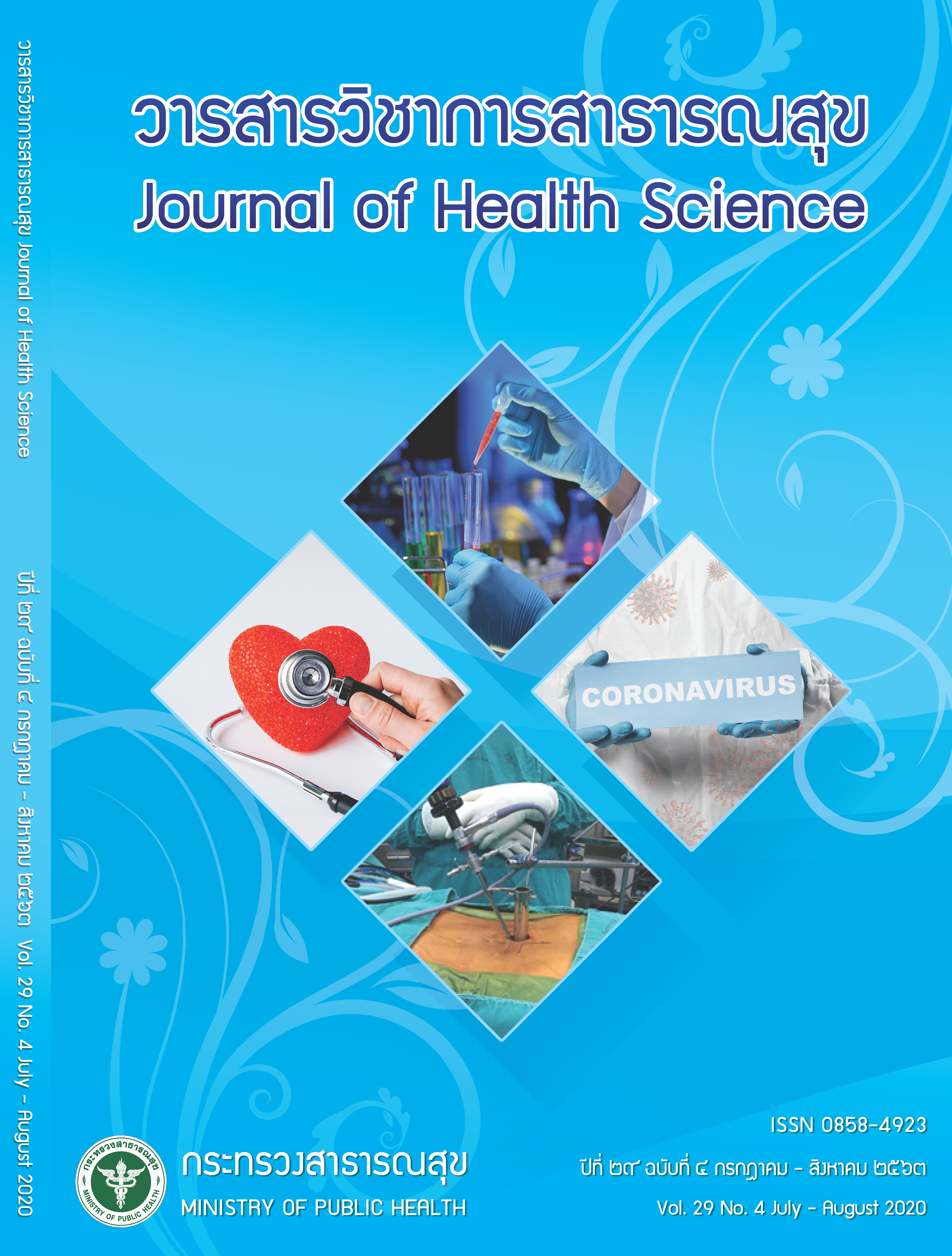Comparative Study on Fetal Weight Estimation in Labor Using Dare’s and Johnson’s Formula and Correlation with Neonatal Birth Weight
Keywords:
fetal weight, birth weight estimation, neonatal birth weightAbstract
Fetal weight estimation helps midwife makes decision about safe delivery planning. The objective of this study was to compare the results of fetal weight estimation obtained from Dare’s formula and Johnson’s formula. It was conducted as a retrospective descriptive research among 115 pregnant women delivered at the Labor room in Dankhunthot Hospital Nakhon Ratchasima Province. Data were collected from labor records of each cases. Demographic data was analyzed using descriptive statistics; and the differences between the mean fetal weight estimation using Dare’s and Johnson’s formula were compared by using paired t test. The correlation between fetal weight estimation using 2 method and factors of the pregnant with neonatal birth weight were analyzed by using Pearson’s product moment correlation coefficient. It was found that there were discrepancies between mean fetal weight estimation from Dare’s and Johnson’s formula and the real neonatal birth weight, with the mean values of 111.77 grams (SD=239.81) for the Dare’s formula and 356.33 grams (SD=447.89) for the Johnson’s formula; and significant correlation between the estimated weight and the real weight was observed with the r value of 0.72 and 0.44 for Dare’s and Johnson’s formula, respectively (p<.05). The maternal factors significantly associated with the neonatal birth weight included the height of fundus, gestational age and abdominal circumference (r=0.50, 0.36 and 0.33, respectively, p<0.01). Based on the outcomes, it could be concluded that fetal weight estimation during intrapartum with the Dare’s formula was more accurate than the Johnson’s formula. In conclusion, the Dare’s formula is an easy and convenient method of screening of fetal macrosomia or intrauterine growth restriction. It can be used to obtain basic information during intrapartum nursing care, with regard to the making of a decision either to continue the delivery services or to refer the pregnant woman to a tertiary care hospital.
Downloads
References
Royal College of Obstetricians & Gynecologists. Shoul-der dystocia green-top guideline No. 42. 2nd edition [Internet]. London: Nice Accredited; 2012 [cited 2019 Sep 1]. Available from: https://www.rcog.org.uk/ en/guidelines-research-services/guidelines/gtg42/
รุ่งนภา รู้ชอบ, นิตยา สินสุกใส, วรรณา พาหุวัฒนกร, ดิฐกานต์ บริบูรณ์หิรัญสาร. ปัจจัยทำนายการคลอดทารกแรก เกิดน้ำหนักน้อย. วารสารพยาบาลศาสตร์ 2558;33(3):18-29.
ใจทิพย์ รุจนเวช. ความแม่นยำในการทำนายน้ำหนักทารกในครรภ์โดยใช้สมการ Hadlock และ Shepard. ศรีนครินทร์เวชสาร 2551;23(2):147-52.
ขจรศิลป์ ผ่องสวัสดิ์กุล. การคาดคะเนน้ำหนักทารกแรกเกิดโดยใช้ผลคูณระหว่างความสูงของมดลูกและเส้นรอบวงหน้าท้องมารดาที่ระดับสะดือเมื่อเจ็บครรภ์คลอด. พุทธชินราช เวชสาร 2550;24(1):15-21.
อรพินทร์ เตชรังสรรค์, วันเพ็ญ สุขส่ง. การศึกษาเปรียบเทียบน้ำหนักทารกที่ได้จากผลคูณความสูงของมดลูกกับเส้นรอบวงหน้าท้องมารดาที่ระดับสะดือ: กรณีศึกษาโรงพยาบาลสมเด็จพระบรมราชเทวี ณ ศรีราชา สภากาชาดไทย. วารสาร-พยาบาลสภากาชาดไทย 2561;11(1):161-70.
Yiheyis A, Alemseged F, Segni H. Johnson’s Formula for Predicting Birth Weight in Pregnant Mothers at Jim-ma University Teaching. Hospital, South West Ethiopia. Med J Obstet Gynecol 2016;4(3):1087-93.
Asto MD, Crisologo MP. Comparative study of four methods of clinical estimation of fetal weight in the late third trimester admitted for delivery: A prospective study. Philippine Journal of Obstetrics and Gynecology 2014; 38(4):14-22.
Buchmann E, Tlale K. A simple clinical formula for predicting fetal weight in labour at term --derivation and validation. S Afr Med J 2009;99(6):457-60.
Gajendra ST, Tripathi A, Priyanka. Comparison of esti-mation of fetal weight by two clinical methods and ul-trasound at term pregnancy. Int J Med Health Res 2017;3(2):25-8.
นุสรา พัวรัตนอรุณกร. การคาดคะเนน้ำหนักทารกในครรภ์. วารสารวิชาการสาธารณสุข 2551;17(5):SV1377-84.
Itarat Y, Buppasiri P, Sophonvivat S. Fetal weight esti-mation using symphysio-fundal height and abdominal girth measurements in different pre-pregnancy Body Mass Indices. Taiwanese Journal of Obstetrics and Gynecolo-gy 2560;25(3):167-74.
งานห้องคลอด โรงพยาบาลด่านขุนทด. รายงานการคลอด โรงพยาบาลด่านขุนทด พ.ศ. 2559 - 2561. นครราชสีมา: โรงพยาบาลด่านขุนทด; 2561.
นิพิฐพนธ์ สนิทเหลือ, วัชรีพร สาตร์เพ็ชร์, ญาดา นภาอารักษ์. การคำนวณขนาดตัวอย่างด้วยโปรแกรมสำเร็จรูป G*POWER. วารสารสถาบันเทคโนโลยีแห่งสุวรรณภูมิ (สาขามนุษยศาสตร์และสังคมศาสตร์) [อินเทอร์เน็ต]. 2562 [สืบค้นเมื่อ 18 ม.ค. 2562];5(1):496-507. แหล่งข้อมูล: https://so04.tci-thaijo.org/index.php/svittj/article/download/181958/136948/
บุญใจ ศรีสถิตนรากูร. ระเบียบวิธีการวิจัยทางพยาบาลศาสตร์. พิมพ์ครั้งที่ 5. กรุงเทพมหานคร: ยูแอนด์ไอ อินเตอร์ มีเดีย; 2553.
Dare FO, Ademowore AS, Ifaturoti OO, Nganwuchu A. The value of symphysio-fundal height/ abdominal girth measurements in predicting fetal weight. Int J Gynaecol Obstet 1990;31(3):243-8.
Johnson RW. Calculations in estimating fetal weight. Am J Obstet Gynecol 1957;74(4):929-30.
Downloads
Published
How to Cite
Issue
Section
License

This work is licensed under a Creative Commons Attribution-NonCommercial-NoDerivatives 4.0 International License.







